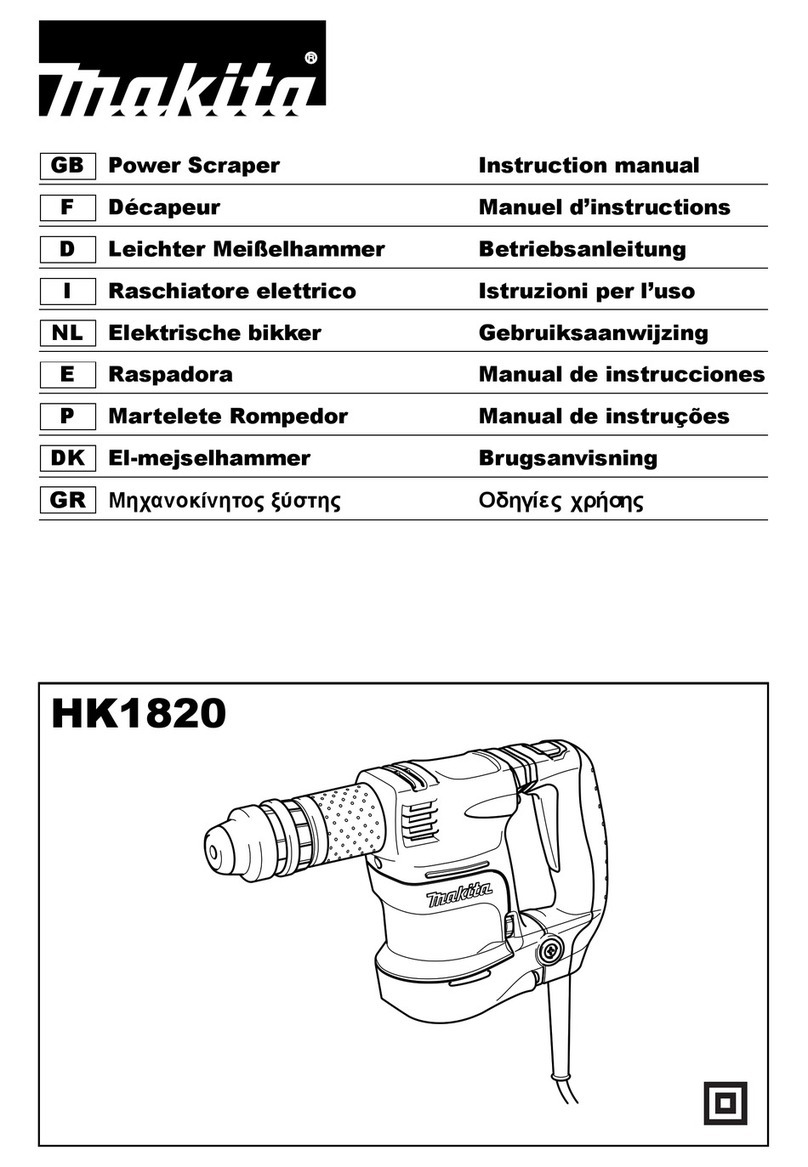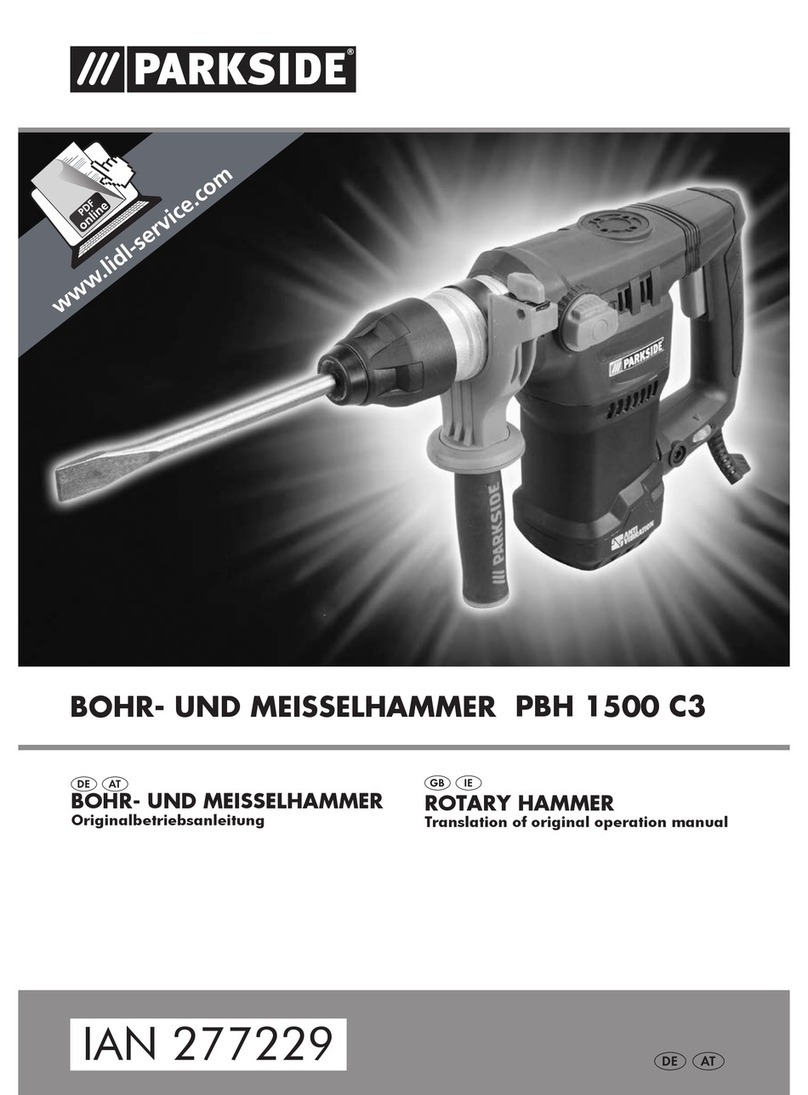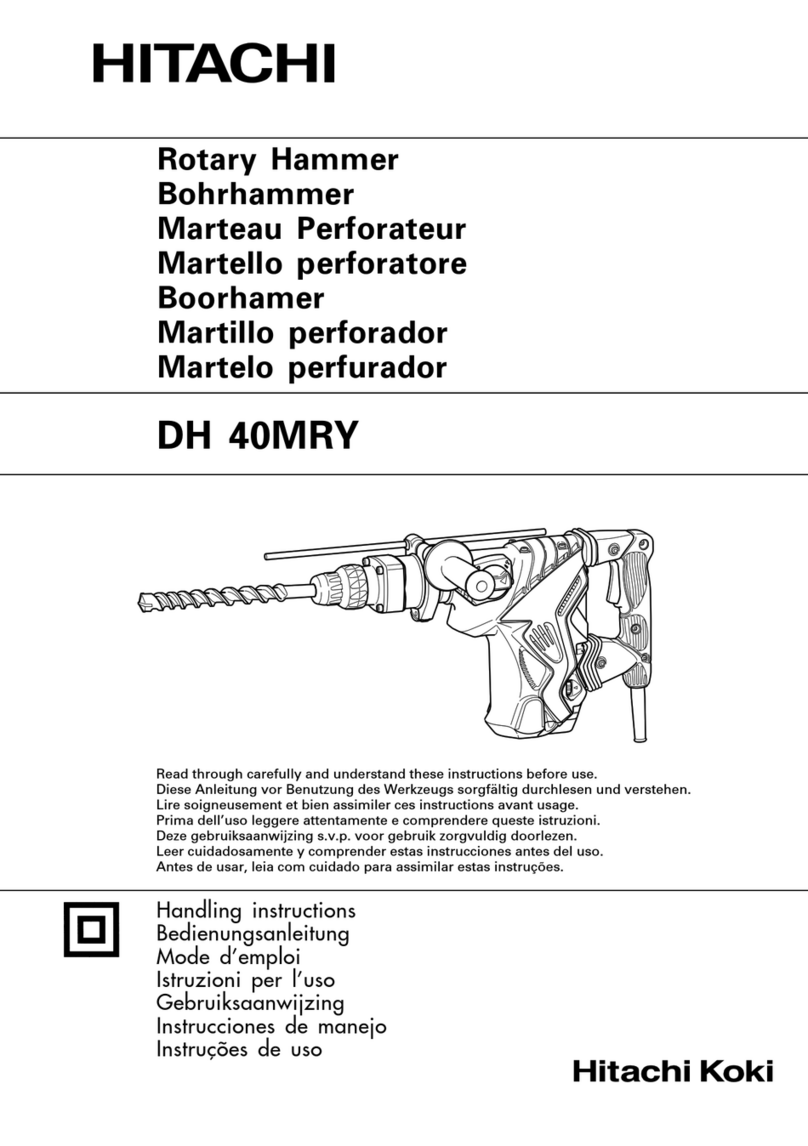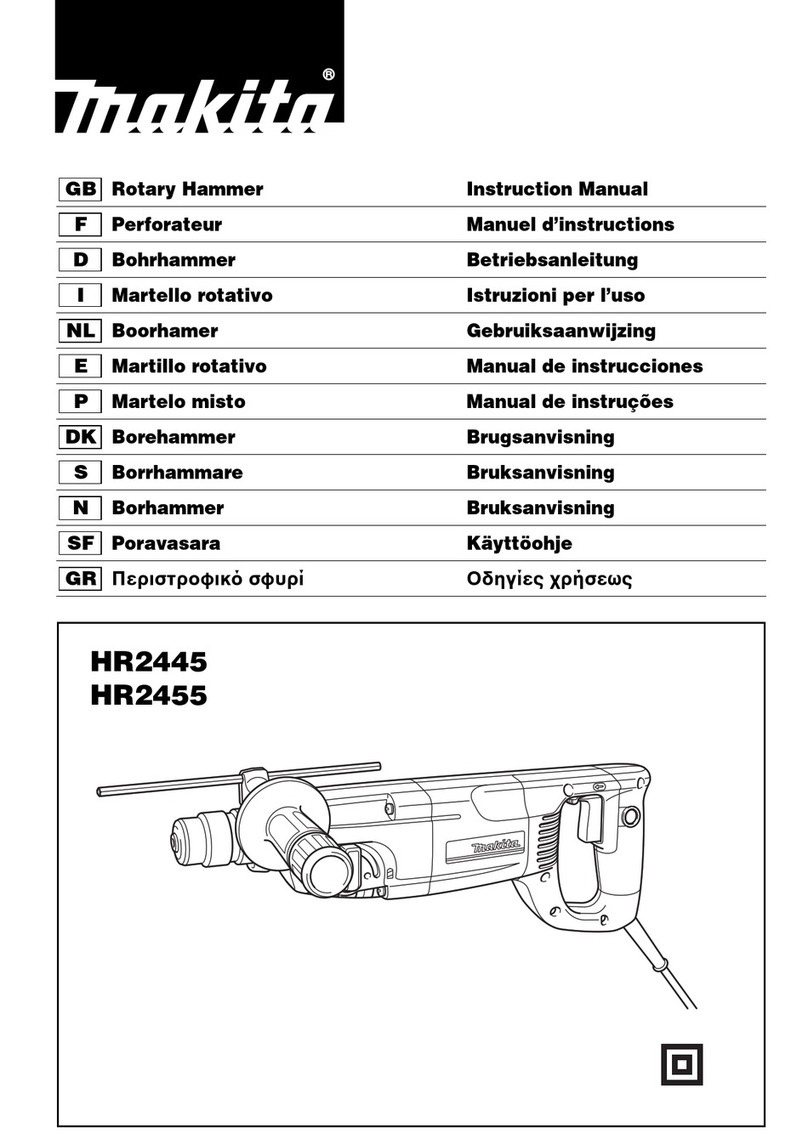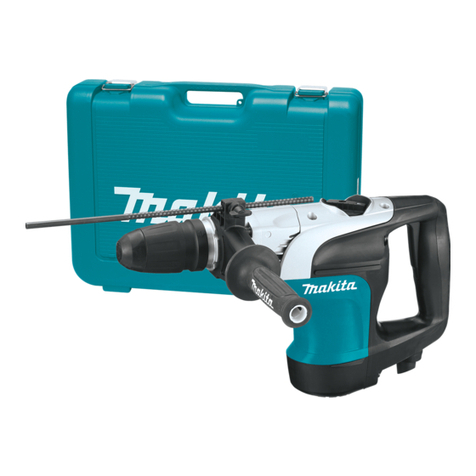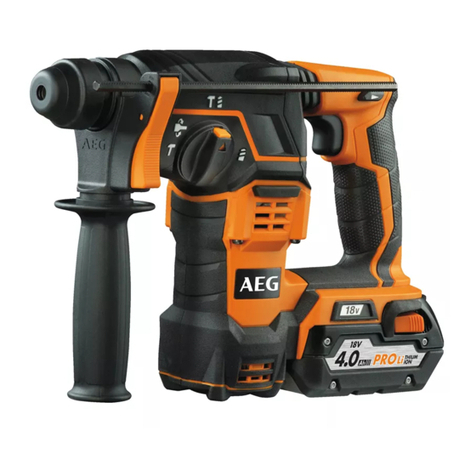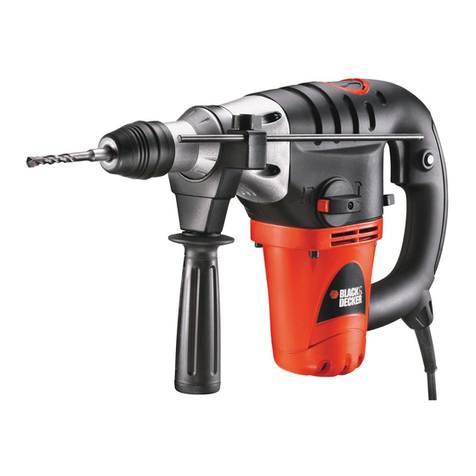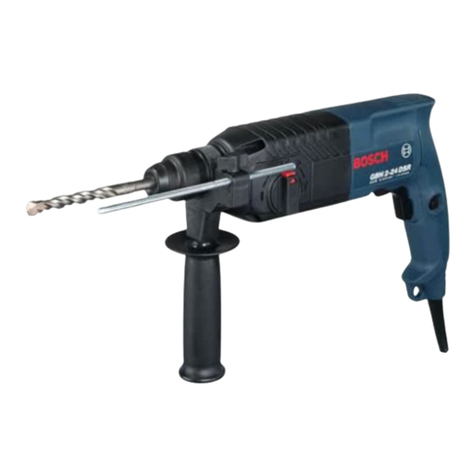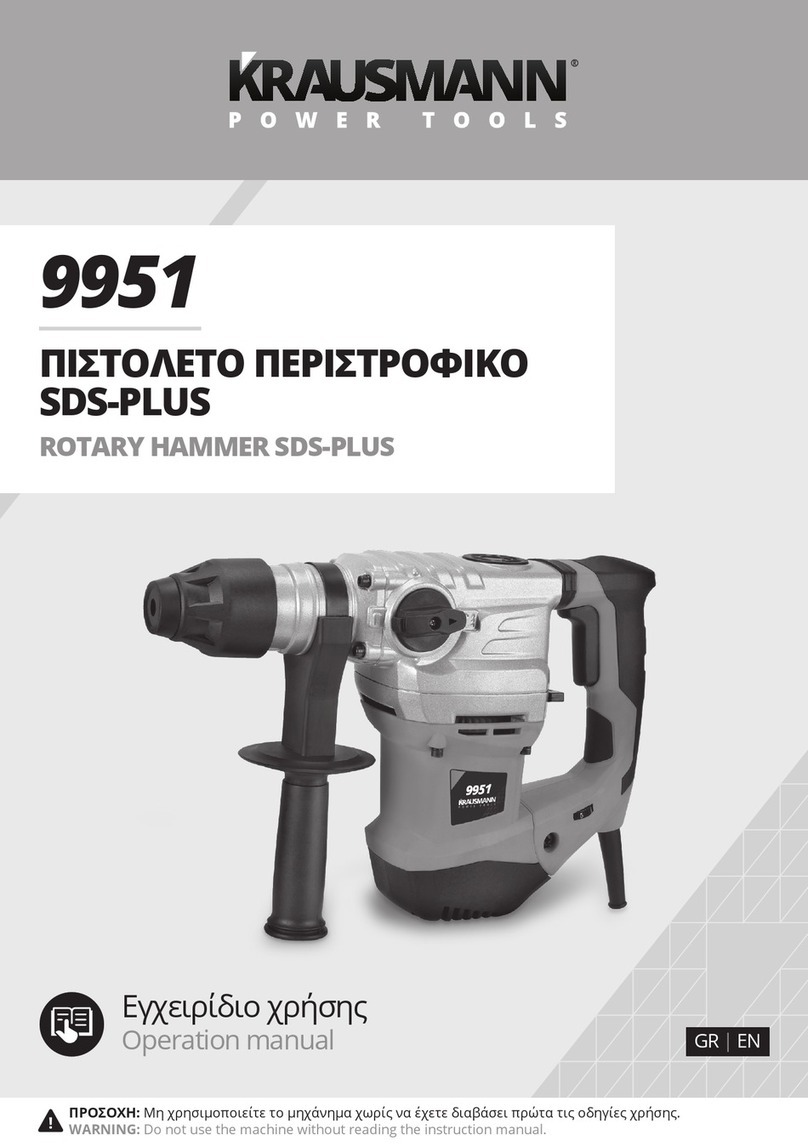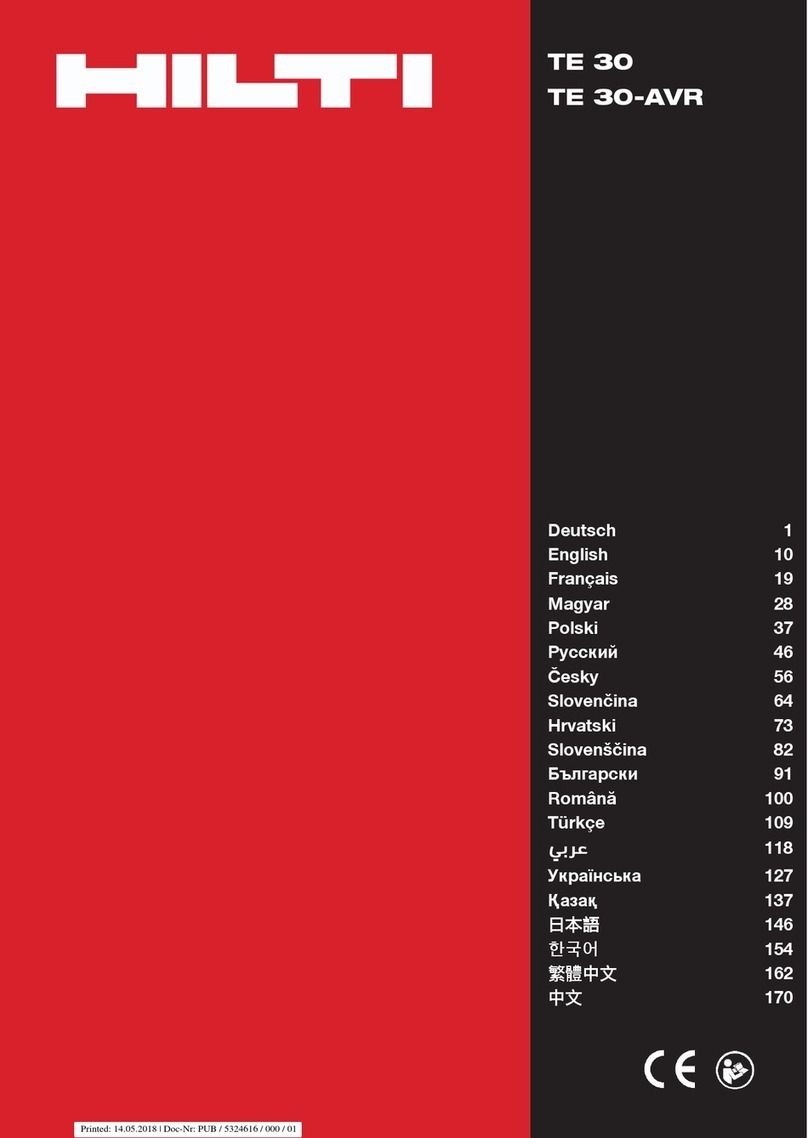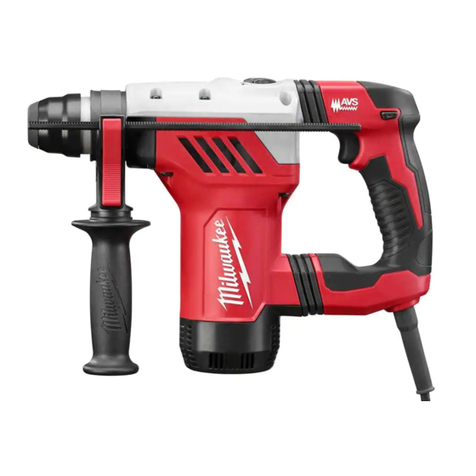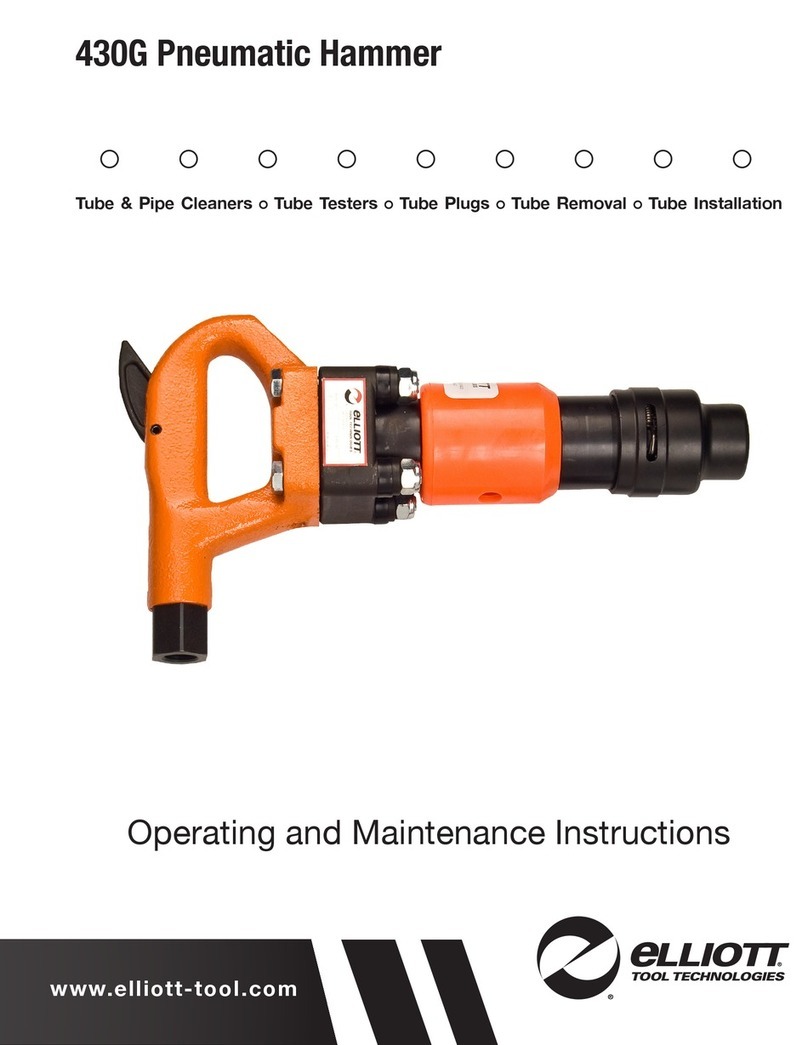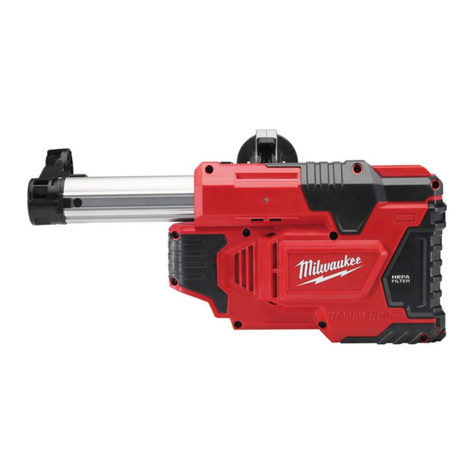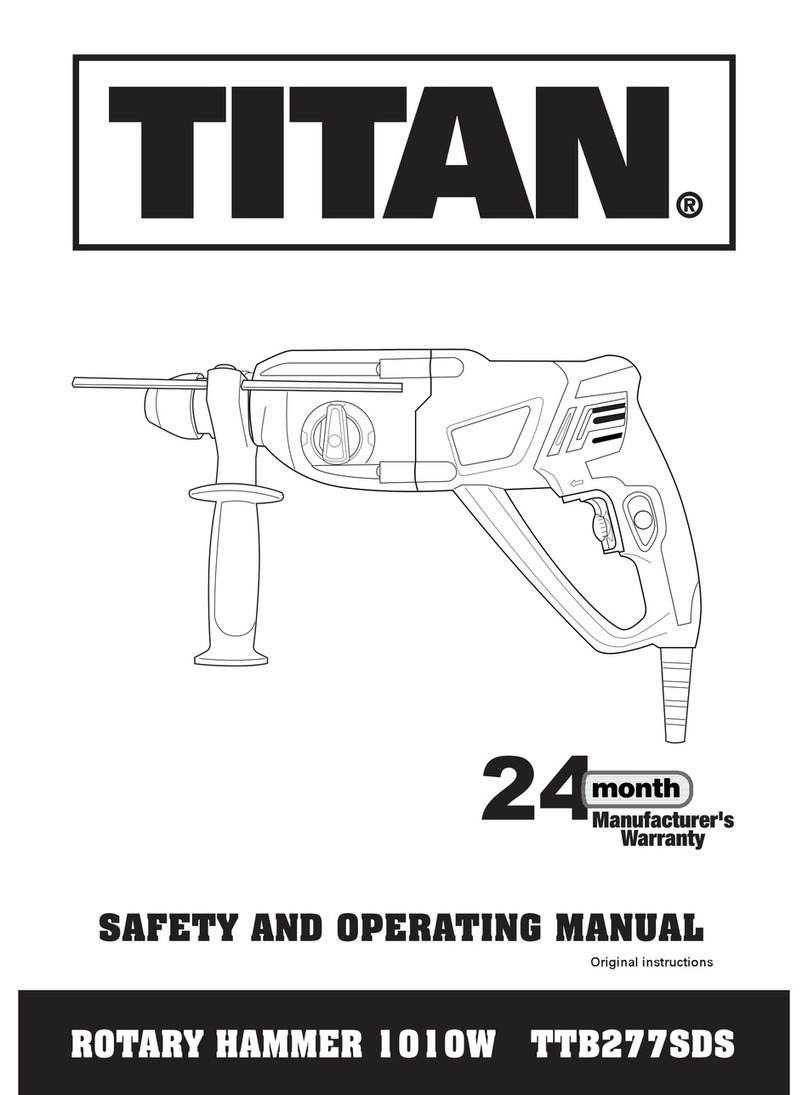Chicago Electric 97743 Installation manual

ROTARY HAMMER - 1”
Model
97743
SET UP AND OPERATING INSTRUCTIONS
Diagrams within this manual may not be drawn proportionally.
Due to continuing improvements, actual product may differ slightly from the product described herein.
Distributed exclusively by Harbor Freight Tools®.
3491 Mission Oaks Blvd., Camarillo, CA 93011
Visit our website at: http://www.harborfreight.com
Read this material before using this product.
Failure to do so can result in serious injury.
SAVE THIS MANUAL.
Copyright©2008 by Harbor Freight Tools®. All rights reserved. No portion of this
manual or any artwork contained herein may be reproduced in any shape or form
without the express written consent of Harbor Freight Tools.
For technical questions or replacement parts, please call 1-800-444-3353.

Page 2SKU 97743 For technical questions, please call 1-800-444-3353.
SAVE THIS MANUAL
Keep this manual for the safety
warnings and precautions, assembly,
operating, inspection, maintenance and
cleaning procedures. Write the product’s
serial number in the back of the manual near
the assembly diagram (or month and year of
purchase if product has no number). Keep
this manual and the receipt in a safe and dry
place for future reference.
IMPORTANT SAFETY
INFORMATION
In this manual, on the labeling,
and all other information
provided with this product:
This is the safety alert
symbol. It is used to alert
you to potential personal
injury hazards. Obey all
safety messages that
follow this symbol to avoid
possible injury or death.
DANGER indicates
a hazardous
situation which, if not
avoided, will result in death or
serious injury.
WARNING
indicates a
hazardous situation which, if
not avoided, could result in
death or serious injury.
CAUTION, used
with the safety
alert symbol, indicates a
hazardous situation which, if
not avoided, could result in
minor or moderate injury.
NOTICE is used to
address practices
not related to personal injury.
CAUTION, without
the safety alert
symbol, is used to address
practices not related to
personal injury.
General Power Tool Safety
Warnings
WARNING Read all safety
warnings and instructions.
Failure to follow the warnings and
instructions may result in electric
Save all warnings and
instructions for future reference.
warnings refers to your line-
operated (corded) Rotary Hammer.
Work area safety1.
Keep work area clean and wella.
lit. Cluttered or dark areas invite
accidents.
Do not operate power tools inb.
explosive atmospheres, such as in
the presence of ammable liquids,
gases or dust. Power tools create
sparks which may ignite the dust or
fumes.
Keep children and bystandersc.
away while operating a power tool.
Distractions can cause you to lose
control.
Electrical safety2.
Power tool plugs must match thea.
outlet. Never modify the plug in
any way. Do not use any adapter
plugs with grounded power tools.
Unmodied plugs and matching

Page 3SKU 97743 For technical questions, please call 1-800-444-3353.
outlets will reduce risk of electric
shock.
Avoid body contact with groundedb.
surfaces such as pipes, radiators,
ranges and refrigerators. There is
an increased risk of electric shock if
your body is grounded.
Do not expose power tools to rainc.
or wet conditions. Water entering
a power tool will increase the risk of
electric shock.
Do not abuse the cord. Never used.
the cord for carrying, pulling or
unplugging the power tool. Keep
cord away from heat, oil, sharp
edges or moving parts. Damaged
or entangled cords increase the risk
of electric shock.
When operating a power toole.
outdoors, use an extension cord
suitable for outdoor use. Use of a
cord suitable for outdoor use reduces
the risk of electric shock.
If operating a power tool in a dampf.
location is unavoidable, use a
Ground Fault Circuit Interrupter
(GFCI) protected supply. Use of
a GFCI reduces the risk of electric
shock.
Personal safety3.
Stay alert, watch what you are do-a.
ing and use common sense when
operating a power tool. Do not use
a power tool while you are tired
or under the inuence of drugs,
alcohol or medication. A moment
of inattention while operating power
tools may result in serious personal
injury.
Use personal protective equip-b.
ment. Always wear eye protection.
Safety equipment such as dust mask,
non-skid safety shoes, hard hat, or
hearing protection used for appropri-
ate conditions will reduce personal
injuries.
Prevent unintentional starting.c.
Ensure the switch is in the off-po-
sition before connecting to power
source and/or battery pack, pick-
ing up or carrying the tool. Carry-
ing power tools with your nger on
the switch or energizing power tools
that have the switch on invites acci-
dents.
Remove any adjusting key ord.
wrench before turning the power
tool on. A wrench or a key left at-
tached to a rotating part of the power
tool may result in personal injury.
Do not overreach. Keep propere.
footing and balance at all times.
This enables better control of the
power tool in unexpected situations.
Dress properly. Do not wear loosef.
clothing or jewelry. Keep your
hair, clothing and gloves away
from moving parts. Loose clothes,
jewelry or long hair can be caught in
moving parts.
If devices are provided for the con-g.
nection of dust extraction and col-
lection facilities, ensure these are
connected and properly used. Use
of these devices can reduce dust-
related hazards.
Only use safety equipment thath.
has been approved by an appropri-
ate standards agency. Unapproved
safety equipment may not provide
adequate protection. Eye protection
must be ANSI-approved and breath-
ing protection must be NIOSH-ap-
proved for the specic hazards in the
work area.

Page 4SKU 97743 For technical questions, please call 1-800-444-3353.
Power tool use and care4.
Do not force the power tool. Usea.
the correct power tool for your
application. The correct power tool
will do the job better and safer at the
rate for which it was designed.
Do not use the power tool if theb.
switch does not turn it on and
off. Any power tool that cannot
be controlled with the switch is
dangerous and must be repaired.
Disconnect the plug from thec.
power source before making
any adjustments, changing
accessories, or storing power
tools. Such preventive safety
measures reduce the risk of starting
the power tool accidentally.
Store idle power tools out ofd.
the reach of children and do not
allow persons unfamiliar with the
power tool or these instructions
to operate the power tool. Power
tools are dangerous in the hands of
untrained users.
Maintain power tools. Checke.
for misalignment or binding of
moving parts, breakage of parts
and any other condition that may
affect the power tool’s operation.
If damaged, have the power
tool repaired before use. Many
accidents are caused by poorly
maintained power tools.
Keep cutting tools sharp andf.
clean. Properly maintained cutting
tools with sharp cutting edges are
less likely to bind and are easier to
control.
Use the power tool, accessoriesg.
and tool bits etc. in accordance
with these instructions, taking into
account the working conditions
and the work to be performed.
Use of the power tool for operations
different from those intended could
result in a hazardous situation.
Service5.
Have your power tool serviced bya.
a qualied repair person using
only identical replacement parts.
This will ensure that the safety of the
power tool is maintained.
Percussion and Rotary Hammer
Safety Warnings
Wear ear protectors.1. Exposure to
noise can cause hearing loss.
Use auxiliary handles supplied2.
with the tool. Loss of control can
cause personal injury.
Hold power tools by insulated grip-3.
ping surfaces when performing an
operation where the cutting tool
may contact hidden wiring or its
own cord. Contact with a ″live″ wire
will make exposed metal parts of the
tool ″live″ and shock the operator.
Maintain labels and nameplates on4.
the tool. These carry important safety
information. If unreadable or missing,
contact Harbor Freight Tools for a
replacement.
Do not operate the Rotary Hammer if5.
any of the following problems occur:
Hammer is too hot, insulation is torn,
frayed or missing, or if excessive
sparking occurs.
Move the Switching Knob (24) and6.
Main Handle (91) only when the
Motor is stopped. Attempting to move
either one while the Motor is engaged
will result in abrupt bit rotation, and

Page 5SKU 97743 For technical questions, please call 1-800-444-3353.
Do not allow the bit to stop while in7.
the hole. Remove the bit while it is
still rotating. If the bit stops while in
the hole, do not restart the Rotary
Hammer. Remove the bit from the
Hammer, and then remove the bit
from the workpiece.
Always keep the Power Cord (112)8.
and extension cord (if used) away
from the moving parts of the Rotary
Hammer.
Avoid unintentional starting. Prepare9.
to begin work before turning on the
tool.
Do not lay the tool down until it has10.
come to a complete stop. Moving
parts can grab the surface and pull
the tool out of your control.
When using a handheld power tool,11.
hold the tool with both hands to resist
starting torque.
Do not leave the tool unattended12.
when it is plugged into an electrical
outlet. Turn off the tool, and unplug
it from its electrical outlet before
leaving.
This product is not a toy. Keep it out13.
of reach of children.
People with pacemakers should14.
consult their physician(s) before
proximity to heart pacemaker could
cause pacemaker interference or
pacemaker failure. In addition,
people with pacemakers should:
on.
avoid electrical shock.
grounded. Ground Fault Circuit
Interrupter (GFCI) should also be
implemented – it prevents sustained
electrical shock.
Some dust created by power15.
sanding, sawing, grinding, drilling,
and other construction activities,
contains chemicals known [to the
State of California] to cause cancer,
birth defects or other reproductive
harm. Some examples of these
chemicals are:
cement or other masonry products
chemically treated lumber
Your risk from these exposures
varies, depending on how often you
do this type of work. To reduce your
exposure to these chemicals: work in
a well ventilated area, and work with
approved safety equipment, such as
those dust masks that are specially
particles. (California Health & Safety
Code § 25249.5, et seq.)
The warnings, precautions,16.
and instructions discussed in
this instruction manual cannot
cover all possible conditions and
situations that may occur. It must
be understood by the operator that
common sense and caution are
factors which cannot be built into this
product, but must be supplied by the
operator.

Page 6SKU 97743 For technical questions, please call 1-800-444-3353.
Vibration Safety
This tool vibrates during use.
Repeated or long-term exposure to
vibration may cause temporary or
to the hands, arms and shoulders. To
reduce the risk of vibration-related
Anyone using vibrating tools regularly1.
or for an extended period should
then have regular medical check-
ups to ensure medical problems are
not being caused or worsened from
use. Pregnant women or people
who have impaired blood circulation
nervous system disorders, diabetes,
or Raynaud’s Disease should not
use this tool. If you feel any medical
or physical symptoms related to
vibration (such as tingling, numbness,
medical advice as soon as possible.
Do not smoke during use. Nicotine2.
reduces the blood supply to the
Wear suitable gloves to reduce the3.
vibration effects on the user.
Use tools with the lowest vibration4.
when there is a choice between
different processes.
Include vibration-free periods each5.
day of work.
Grip tool as lightly as possible (while6.
the tool do the work.
To reduce vibration, maintain the tool7.
as explained in this manual. If any
abnormal vibration occurs, stop use
immediately.
SAVE THESE
INSTRUCTIONS.
GROUNDING
TO PREVENT
ELECTRIC SHOCK
AND DEATH FROM
INCORRECT GROUNDING
WIRE CONNECTION:
Check with a qualied
electrician if you are in doubt
as to whether the outlet is
properly grounded. Do not
modify the power cord plug
provided with the tool. Never
remove the grounding prong
from the plug. Do not use the
tool if the power cord or plug
is damaged. If damaged, have
it repaired by a service facility
before use. If the plug will not
t the outlet, have a proper
outlet installed by a qualied
electrician.
Grounded Tools: Tools with Three
Prong Plugs
3-Prong Plug and Outlet
1. Tools marked with “Grounding
Required” have a three wire cord

Page 7SKU 97743 For technical questions, please call 1-800-444-3353.
and three prong grounding plug.
The plug must be connected to a
properly grounded outlet. If the tool
should electrically malfunction or
break down, grounding provides a
low resistance path to carry electricity
away from the user, reducing the risk
of electric shock. (See 3-Prong Plug
and Outlet.)
The grounding prong in the plug is2.
connected through the green wire
inside the cord to the grounding
system in the tool. The green wire
in the cord must be the only wire
connected to the tool’s grounding
system and must never be attached
to an electrically “live” terminal. (See
3-Prong Plug and Outlet.)
The tool must be plugged into an3.
appropriate outlet, properly installed
and grounded in accordance with all
codes and ordinances. The plug and
outlet should look like those in the
preceding illustration. (See 3-Prong
Plug and Outlet.)
Double Insulated Tools: Tools
with Two Prong Plugs
Outlets for 2-Prong Plug
1. Tools marked “Double Insulated”
do not require grounding. They
have a special double insulation
requirements and complies with the
applicable standards of Underwriters
Standard Association, and the
National Electrical Code. (See
Outlets for 2-Prong Plug.)
Double insulated tools may be used2.
in either of the 120 volt outlets shown
in the preceding illustration. (See
Outlets for 2-Prong Plug.)
Extension Cords
Grounded tools require a three wire1.
extension cord. Double Insulated
tools can use either a two or three
wire extension cord.
As the distance from the supply2.
outlet increases, you must use a
heavier gauge extension cord. Using
extension cords with inadequately
sized wire causes a serious drop in
voltage, resulting in loss of power and
possible tool damage.
(See Table A.) The smaller the
gauge number of the wire, the
greater the capacity of the cord. For
example, a 14 gauge cord can carry
a higher current than a 16 gauge
cord. (See Table A.)
When using more than one extension3.
cord to make up the total length,
make sure each cord contains at
least the minimum wire size required.
(See Table A.)
If you are using one extension cord4.
for more than one tool, add the
nameplate amperes and use the sum
to determine the required minimum
cord size. (See Table A.)
If you are using an extension cord5.
outdoors, make sure it is marked with

Page 8SKU 97743 For technical questions, please call 1-800-444-3353.
indicate it is acceptable for outdoor
use.
Make sure the extension cord is6.
properly wired and in good electrical
condition. Always replace a damaged
extension cord or have it repaired by
Protect the extension cords from7.
damp or wet areas.
RECOMMENDED MINIMUM WIRE
GAUGE FOR EXTENSION CORDS*
(110/220 VOLT)
NAMEPLATE
AMPERES
(at full load)
EXTENSION CORD
LENGTH
25’
50’
75’
100’
150’
0 – 2.0 18 18 18 18 16
2.1 – 3.4 18 18 18 16 14
3.5 – 5.0 18 18 16 14 12
5.1 – 7.0 18 16 14 12 12
7.1 – 12.0 18 14 12 10 -
12.1 – 16.0 14 12 10 - -
16.1 – 20.0 12 10 - - -
TABLE A
* Based on limiting the line
voltage drop to ve volts at
150% of the rated amperes.
Symbology
Double Insulated
Canadian Standards Association
V~ Volts Alternating Current
AAmperes
n0
(RPM)
SPECIFICATIONS
Electrical
Requirements
2-Prong, Polarized Power Plug
Speed n0
Blows Per
Minute 2920 BPM
Capacity 1”
Chuck Type SDS
Rotation Clockwise (non-reversible)
Applications
For drilling stone, concrete, and
other hard and brittle materials.
For chiseling.
Accessories
Wrench
4-Point Chisel
Container of Grease
Carbon Brush Set
Depth Gauge Rod
Auxiliary Handle
Carrying Case
E194601
UNPACKING
When unpacking, check to make sure
that the item is intact and undamaged. If
any parts are missing or broken, please call
Harbor Freight Tools at the number shown
on the cover of this manual as soon as pos-
sible.

Page 9SKU 97743 For technical questions, please call 1-800-444-3353.
SET UP INSTRUCTIONS
Read the ENTIRE IMPORTANT SAFETY INFORMATION section at the
beginning of this manual including all text under subheadings therein
before set up or use of this product.
TO PREVENT SERIOUS INJURY FROM ACCIDENTAL
OPERATION:
Turn the Power Switch (96) of the Rotary Hammer to its “OFF” position
and unplug the tool from its electrical outlet before assembling or
making any adjustments to the tool.
Note: For additional information regarding the parts listed in the following pages, refer
to the Assembly Diagram near the end of this manual.
Product Features
POWER SWITCH
(96)
SWITCHING KNOB
(24)
SPRING
(41)
DEPTH GAUGE
(106)
AUXILIARY HANDLE
(107)
BRUSH COVER (81)
CARBON BRUSH (82)
SELECTOR
(91)
GREASE CAP
(18)
FRONT COVER
(39)
FIGURE A
HANDLE HOLDER
(108)

Page 10SKU 97743 For technical questions, please call 1-800-444-3353.
Tool Set Up
Adjusting The Auxiliary Handle:
The Auxiliary Handle (107) can be1.
placed in a variety of positions.
(See Figure A.)
To rotate the Auxiliary Handle2.
(107), turn the Auxiliary Handle
counterclockwise to loosen the band
and Foursquare Bolt (111). Once
loosened, turn the Auxiliary Handle
to the desired position. Then turn the
Handle clockwise to secure in place.
(See Figure A.)
Using The Depth Gauge:
The Depth Gauge (106) can only be1.
used if the Auxiliary Handle (107) is
positioned on either side or the top of
the Rotary Hammer. The body of the
Hammer will interfere with the Depth
Gauge if the Handle is in the bottom
position. (See Figure A.)
2.
turning the Handle counterclockwise.
(See Figure A.)
Once the Auxiliary Handle (107) is3.
Handle Holder (108) until the hole in
the Handle is fully open.
(See Figure A.)
Slide the Depth Gauge (106) in to the4.
desired length. The tip of the Depth
Gauge on the front of the Hammer
should be the desired depth of the
hole to be drilled. The depth is from
the tip of the Drill Bit to the tip of the
Depth Gauge.
For example; for a 2” deep hole,
measure 2” back from the tip of the
Drill Bit. Then position the front tip
of the Depth Gauge at that spot.
(See Figure A.)
After the Depth Gauge (106) is5.
placed in the desired position, turn
the Auxiliary Handle (107) clockwise
until tight. The Depth Gauge should
be securely in position and should not
move. (See Figure A.)
Changing The Settings:
The Rotary Hammer has a Switching1.
Knob (24) and a Selector (91) which
hammer drilling, or chiseling.
(See Figure A.)
WARNING!2. Move the Switching
Knob (24) and Selector (91)
only when the Motor is stopped.
Attempting to move the Switching
Knob or Selector while the Motor
is engaged will result in abrupt Bit
rotation and can cause serious
damage.
(See Figure A.)
CAUTION:3. When moving the
Switching Knob (24) and Main
Handle (91), make sure both actively
“click” into the desired position. If not
actively engaged, the Knob or Handle
could slip out of position resulting in
unexpected tool performance.
(See Figure A.)
The front Switching Knob (24) has on4.
one side a symbol of a Hammer and
a Drill. On the other side is a symbol
(See Figure A.)
The Main Handle (91) can be pointed5.
either left or right. There are symbols
for a Hammer and a Drill on the left

Page 11SKU 97743 For technical questions, please call 1-800-444-3353.
side and a symbol for a Drill only on
the right side. (See Figure A.)
To drill only: Set the Switching
Knob (24) so that the symbol of
the Hammer and Drill are facing
forward. Then turn the Selector
(91) so that it points to the right at
the Drill symbol. (See Figure A.)
To hammer drill: Set the Switching
Knob (24) so that the symbol of
the Hammer and Drill are facing
forward. Then turn the Selector
(91) so that it points to the left at the
Hammer and Drill symbol.
(See Figure A.)
To chisel: Set the Switching Knob
(24) so that the symbol of the
Hammer only points forward. Then
turn the Selector (91) so that it
points left to the Hammer and Drill
symbol. (See Figure A.)
NOTE: Break Point (Bull) bits and
cold chisels should be used when
the Switches are in the hammering
chisels with the Switches in the
unexpected tool performance.
Workpiece and Work Area Set Up
Designate a work area that is clean1.
and well-lit. The work area must not
allow access by children or pets to
Route the Power Cord (112) along2.
a safe route to reach the work area
without creating a tripping hazard or
exposing the Power Cord to possible
damage. The Power Cord must
reach the work area with enough
extra length to allow free movement
while working.
Secure loose workpieces using a vise3.
or clamps (not included) to prevent
movement while working.
There must not be hazardous4.
hazard while working.
OPERATING INSTRUCTIONS
Read the ENTIRE IMPORTANT
SAFETY INFORMATION section
at the beginning of this manual
including all text under
subheadings therein before set
up or use of this product.
Inserting and Removing Drill Bits:
CAUTION:1. Always wear heavy duty
work gloves to provide protection
when inserting and removing drill bits.
Drill bits become very hot in use. Do
not remove drill bits until the bit has
completely cooled. Do not strike
stuck bits with a hammer as metal
the Power Cord (112) from its
electrical outlet when inserting and
removing bits and chisels.
Add a light coating of grease or2.
machine oil to the drill bit shank.
Pull back on the Spring (41) while at3.
the same time inserting and turning
the Drill Bit until it slides all the way in
the Front Cover (39). Then release
the Spring so that it returns to its
original position. NOTE: You should
not be able to move the Bit without
pulling back on the Spring again.
Make sure the Bit does not move to
ensure that it is properly locked in
place. (See Figure A.)

Page 12SKU 97743 For technical questions, please call 1-800-444-3353.
To remove the Drill Bit, pull back on4.
the Spring (41) and pull out the Bit.
For optimal performance, always
keep Drill Bits and Chisels sharp.
NOTE: When drilling a hole larger
Drill Bit with four cutting edges.
(See Figure A.)
General Operating Instructions
Before plugging in the Power Cord1.
the Auxiliary Handle (107) and Depth
Gauge (106) to the desired positions.
(24) and Selector (91) to the desired
positions. (See Figure A.)
Make sure the Power Switch (96) is2.
in its “OFF” position. Then plug the
Power Cord (112) into the nearest
110 volt, grounded, electrical outlet.
(See Figure A.)
When ready to use the Rotary3.
Hammer, squeeze the Power Switch
(96) and allow the tool to run without
load for about one minute. This
allows the tool’s parts to become
properly lubricated. Check to see
if the running tool sounds normal.
Once the tool has been warmed up, it
is ready for use. (See Figure A.)
4.
Hammer, release the Power Switch
(96). Wait until the tool comes to a
complete stop. Then unplug the tool
from its electrical outlet. (See Figure
A.)
Make sure the Drill Bit is completely5.
cooled. Then remove the Bit from
the tool.
Store the Rotary Hammer in its6.
Carrying Case (105) and keep the
Case in a clean, dry, safe location out
of children’s reach.

Page 13SKU 97743 For technical questions, please call 1-800-444-3353.
MAINTENANCE AND
SERVICING
Procedures not specically
explained in this manual
must be performed only by a
qualied technician.
TO PREVENT
SERIOUS INJURY
FROM ACCIDENTAL
OPERATION:
Turn the Power Switch (96) of
the Rotary Hammer to its
“OFF” position and unplug
the tool from its electrical
outlet before performing any
inspection, maintenance, or
cleaning procedures.
TO PREVENT SERIOUS
INJURY FROM TOOL
FAILURE:
Do not use damaged
equipment. If abnormal noise
or vibration occurs, have the
problem corrected before
further use.
BEFORE EACH USE:1. Inspect
the general condition of the Rotary
Hammer. Check for loose screws,
misalignment or binding of moving
parts, cracked or broken parts,
damaged electrical wiring, and any
other condition that may affect its
safe operation.
AFTER EVERY 50 HOURS OF USE:2.
Use the Spanner Wrench provided to
unscrew the Grease Cap (18). Add
the Grease provided. Then, replace
and tighten the Grease Cap. NOTE:
The Rotary Hammer is pre-greased
only needed beginning after about 50
hours of use. (See Figure A.)
TO CHANGE OR CLEAN THE3.
CARBON BRUSHES: It may
become necessary at sometime
to replace or clean the two
Carbon Brushes (82) when Motor
performance decreases, or stops
working completely. The Carbon
Brushes are located on each side of
the Motor Housing (78). To change
or clean the Carbon Brushes:
Remove the two Brush Covers
(81). Then remove the Carbon
Brushes.
If the Carbon Brushes (82) are worn
Brushes.
If the Carbon Brushes (82) are
only dirty, they may be cleaned by
rubbing them with a pencil eraser.
When installing the Carbon Brushes
(82), make sure the carbon portion
of the Brushes contact the Motor
Armature, and that the springs face
away from the Armature. Also,
make sure the springs operate
freely. After replacing or cleaning,
replace the two Brush Covers (81).
NOTE: New Carbon Brushes (82)
until they wear and conform to the
Armature. (See Figure A.)
AFTER USE:4. Clean external
surfaces of the tool with a clean cloth.
WARNING! If the Power Cord5.
(112) of this Rotary Hammer is
damaged, it must be replaced only
by a qualied service technician.

Page 14SKU 97743 For technical questions, please call 1-800-444-3353.
TROUBLESHOOTING
Problem Possible Causes Probable Solutions
Tool will not start. No power at outlet.1.
Cord not connected.2.
Blown fuse or tripped circuit3.
breaker.
Check power at outlet.1.
Check that cord is plugged in.2.
Replace fuse or reset circuit breaker.3.
Motor does not
rotate with power
switch depressed.
Disrupted power supply.1.
Poor contact at the switch.2.
3.
Broken stator coil.4.
Carbon brushes worn out.5.
Check power supply.1.
Repair switch.2.
Change coil.3.
Replace stator coil.4.
Replace carbon brushes.5.
Abnormal noise
from motor. Does
not rotate, or
rotates slowly.
Overload of motor caused by
excessive drilling pressure.
Reduce drilling pressure. Decrease force.
Partial short
circuit.
Partial short circuit or open circuit
at armature.
Repair or change armature.
Main voltage too
low.
Main power voltage too low.
Gearbox becomes
too hot.
Overload. Dull bit.1.
Damp coils.2.
3.
Decrease in voltage.4.
Reduce load. Sharpen bit.1.
Dry coils.2.
Repair or change armature.3.
4.
Sparking. Short circuit or break at1.
armature.
Surface of armature not2.
smooth and clean.
New carbon brushes installed.3.
Repair armature.1.
Inspect and clean armature.2.
Normal condition. Sparking will discontinue3.
with the armature.
Follow all safety precautions whenever diagnosing or servicing the
tool. Disconnect power supply before service.

Page 15SKU 97743 For technical questions, please call 1-800-444-3353.
Part # Description Qty.
1 O-Ring 1
2 Steel Ball 3
3 Cylinder 1
4 Feather Key 2
5 Piston 1
6 O-Ring 1
7 Spring Holder 1
8 Spring 1
9 Clutch 1
10 Third Gear 1
11 O-Ring 1
12 Piston 1
13 Connecting Shaft 1
14 Needle Bearing 1
15 O-Ring 1
16 O-Ring 1
18 Grease Cap 1
19 Gear Housing 1
20 Name Plate 1
21 2
22 Slide Bearing 2
23 Screw 1
24 Switching Knob 1
25 1
26 Auxiliary 1
28 Handle Seat 2
29 Handle Bracket 1
30 Screw (M5x25) 4
31 Spring 4
32 Cylinder Case 1
33 Cylinder Cap 1
34 Oil Seal 1
Part # Description Qty.
35 Washer 1
36 Bearing 1
37 Distance Ring 1
38 Distance Cover 1
39 Front Cover 1
40 O-Ring 1
41 Spring 1
42 Steel Column 2
43 Retainer Sleeve 1
44 O-Ring 2
45 O-Ring 2
46 Second Hammer 1
47 Spring 1
48 Name Plate 1
49 Oil Seal Ring 1
50 Gear Bearing 1
51 Distance Ring 1
52 Bearing 1
53 Spacer 1
54 Washer 2
55 Slip Plate 2
56 Gear (No. 2) 1
57 Spring Washer 1
58 Special Nut 1
59 Bearing 1
60 Crank Shaft 1
61 Steel Ball 3
62 Bearing 1
63 Washer 1
64 Bearing Cover 1
65 Screw (M5x60) 2
66 Gear (No. 1) 1
PARTS LIST

Page 16SKU 97743 For technical questions, please call 1-800-444-3353.
PARTS LIST (CONTINUED)
PLEASE READ THE FOLLOWING CAREFULLY
DISTRIBUTOR MAKES ANY REPRESENTATION OR WARRANTY OF ANY KIND TO THE BUYER THAT
Part # Description Qty.
67 Washer 1
68 Spring 1
69 Clutch Shaft 1
70 Center Cover 1
71 Bearing 1
72 Armature 1
73 Fan Guide 1
74 Field Screw 2
75 Washer 2
77 Bearing 1
78 Housing 1
79 Washer 4
80 Screw (M5x50) 4
81 Brush Cover 2
82 Carbon Brush 2
83 Brush Holder 2
84 Tapping Screw 2
85 Back Cover 1
86 Fixed Screw (M5x6) 2
87 ST Screw (M4x23) 3
88 Needle Bearing 1
89 Spring Holder 1
90 O-Ring 1
91 Selector 1
Part # Description Qty.
92 1
93 Insulating Sleeve 4
94 Switch Cover 1
96 Power Switch 1
97 Cord Pressing Board 1
98 ST Screw (M4x16) 2
99 Board 1
101 Right Handle Cover 1
102 ST Screw (M5x25) 2
103 Screw (M5x25) 2
104 Dust Cover 1
105 Carrying Case 1
106 Depth Gauge 1
107 Auxiliary Handle 1
108 Handle Holder 1
109 Handle Shaft 1
110 Pressing Board 1
111 Four Square Bolt 1
112 Power Cord 1
113 Piston Pin 1
114 Slide Bearing 1
115 Stator 1
116 Steel Ball 1

Page 17SKU 97743 For technical questions, please call 1-800-444-3353.
ASSEMBLY DIAGRAM
1
6
5
4
3
2
113
12
13 14 15
7
9
10
8
104
105
106
107
108
19
18
16
111
110
109
20
11
23
30
28
29
26
25
22
21 24
33
32
31
34
114
38
37
36
35
39 40
42
41
44
43
46
45
47
116
58
59
53
52
48
49
50
51
57
55
54
55
56
54
60
31 64
63
61
62
65
69
68
66
67
70
77
75
74
73
72
71
78
80
79
81
84
8382
87
86
85
88
89
91
115
90
94
93
92
96 97
98
99
112
103
101
102
REV 09e

Page 18SKU 97743 For technical questions, please call 1-800-444-3353.
LIMITED 90 DAY WARRANTY
Harbor Freight Tools Co. makes every effort to assure that its products meet high
quality and durability standards, and warrants to the original purchaser that this product
is free from defects in materials and workmanship for the period of 90 days from the date
of purchase. This warranty does not apply to damage due directly or indirectly, to misuse,
abuse, negligence or accidents, repairs or alterations outside our facilities, criminal activity,
improper installation, normal wear and tear, or to lack of maintenance. We shall in no event
or consequential damages arising from the use of our product. Some states do not allow
the exclusion or limitation of incidental or consequential damages, so the above limitation
of exclusion may not apply to you.
To take advantage of this warranty, the product or part must be returned to us with
transportation charges prepaid. Proof of purchase date and an explanation of the complaint
repair or replace the product at our election or we may elect to refund the purchase price
if we cannot readily and quickly provide you with a replacement. We will return repaired
products at our expense, but if we determine there is no defect, or that the defect resulted
from causes not within the scope of our warranty, then you must bear the cost of returning
the product.
vary from state to state.
3491 Mission Oaks Blvd. • PO Box 6009 • Camarillo, CA 93011 • (800) 444-3353
Record Product’s Serial Number Here:
Note: If product has no serial number, record month and year of purchase instead.
Note: Some parts are listed and shown for illustration purposes only, and are not
available individually as replacement parts.
Table of contents
Other Chicago Electric Rotary Hammer manuals

Chicago Electric
Chicago Electric 69274 User manual

Chicago Electric
Chicago Electric 69334 Assembly instructions

Chicago Electric
Chicago Electric 93722 User manual

Chicago Electric
Chicago Electric 90827 User manual

Chicago Electric
Chicago Electric 94944 User manual

Chicago Electric
Chicago Electric 47606 Installation manual

Chicago Electric
Chicago Electric ITEM 69276 Instruction Manual

Chicago Electric
Chicago Electric 41983 User manual

Chicago Electric
Chicago Electric 41983 User manual

Chicago Electric
Chicago Electric 02957 User manual
